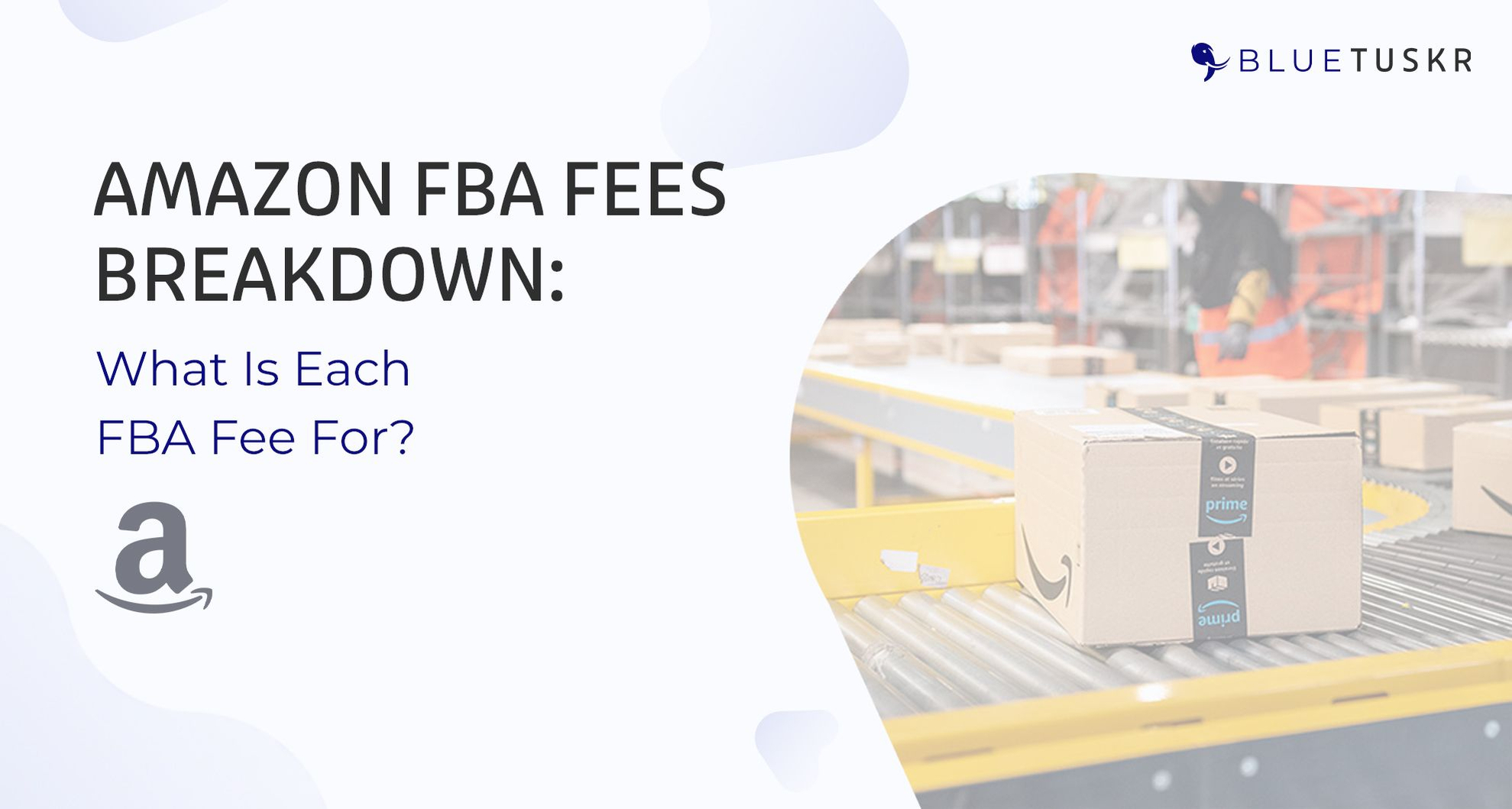
Amazon FBA Fees Breakdown: What Is Each FBA Fee For? - Updated 2023
Whether you’re looking to get started as an Amazon seller or already use the platform, you may be wondering if the Fulfillment by Amazon (FBA) program is worthwhile. Sure, there are some obvious benefits, like being able to offer Prime free shipping, but you also have to deal with the costs associated with joining.
By exploring the Amazon FBA fee breakdown, you can estimate the price tag associated with signing up. With that in mind, here’s a look at what Amazon FBA program fees are, who has to pay them, and a full rundown of the various costs.

What Are Amazon FBA Fees?
It’s no secret that being an Amazon seller means dealing with quite a few different kinds of fees. Along with referral, subscription, and per-item fees, you may also have to deal with FBA fees.
FBA fees are designed to cover Amazon’s costs associated with shipping items for you. Along with picking, packing, and mailing expenses, it compensates Amazon for handling returns, customer service, and other costs associated with your items, as well as storing the products in an Amazon facility.
Who Pays Amazon FBA Fees?
While some Amazon fees apply to all sellers – like referral fees – the FBA fees are different. Only sellers who use the FBA program have to deal with FBA fees.
If you handle your own fulfillment or use a different fulfillment center, then you don’t have to deal with these costs. If you are in the latter category, you’ll want to focus on the fee breakdown used at your provider, not Amazon.
Amazon FBA Fee Breakdown
Generally speaking, the Amazon FBA fee breakdown covers two main cost categories. First, there are storage-related costs. These specifically address expenses related to Amazon keeping your products in one of their facilities.
Second, there are order-associated fees. Typically, these address all things shipping-related, as well as compensating Amazon for dealing with returns and customer service.
However, it’s important to note that sellers can encounter other fees. Some of these relate to having inventory removed from Amazon facilities, while others occur when poor planning places a burden on Amazon.
Here’s a rundown of each of those main categories.
Storage Fee Breakdown
Storage fees actually fall into two categories. First, there are monthly inventory storage fees. These compensate Amazon for dedicating space in their warehouses to your items and are usually charged based on the actual amount of room your items take up.
However, the charges do adjust seasonally. During the winter holiday season, the cost is higher than outside of that window. Here is an overview of the monthly inventory storage fees for each season:
- January through September - $0.75 per cubic foot for standard-size items / $0.48 per cubic foot for oversize
- October through December - $2.40 per cubic foot for standard-size items / $1.20 per cubic foot for oversize
Additionally, if the items being stored are considered dangerous, that alters the cost. The main reason for that is hazardous goods are harder to handle and store safely. Here is what the fee breakdown looks like for dangerous goods:
- January through September - $0.99 per cubic foot for standard-size items / $0.78 per cubic foot
- October through December - $3.63 per cubic foot for standard-size items / $2.43 per cubic foot
If an item has been at an Amazon facility for more than a year (365 days), then long-term storage fees become part of the equation. These are charged either at $6.90 per cubic foot or $0.15 per unit, depending on which is greater.
One final storage cost you may encounter in this category is inventory storage overage fees. These occur when you have more items at the fulfillment center than your agreement allows and are charged in conjunction with any other expenses you may have incurred. Generally, it costs $10 per excess cubic foot based on the daily average for that month.
Order Fee Breakdown
Amazon FBA order fees are costs associated with selling an item that Amazon will fulfill. They are charged on a per-unit basis.
The exact amount charged depends on the item’s category (mainly whether it is or isn’t apparel), size, and weight.

Standard Size
Here is an overview of those costs for non-apparel standard size items:
- Small 10 oz or less - $2.50
- Small 10+ oz to 16 oz - $2.63
- Large 10 oz or less - $3.31
- Large 10 oz to 16 oz - $3.48
- Large 1+ to 2 lbs. - $4.90
- Large 2+ to 3 lbs. – $5.42
- Large 3+ to 21 lbs. - $5.42 + $0.38/lb. above 3 lbs
Here is the rundown for apparel standard size items:
- Small 10 oz or less - $2.92
- Small 10+ oz to 16 oz - $3.11
- Large 10 oz or less - $3.70
- Large 10 oz to 16 oz - $3.81
- Large 1+ to 2 lbs. - $5.35
- Large 2+ to 3 lbs. – $5.95
- Large 3+ to 21 lbs. - $5.95 + $0.38/lb. above 3 lbs

Oversize
Oversized items have their own fee structure. Here’s an overview of that:
- Small oversize 71 lbs. or less - $8.26 + $0.38/lb. above 2 lbs
- Medium oversize 151 lbs. or less - $11.37 + $0.39/lb. above 2 lbs
- Large oversize 151 lbs. or less - $75.78 + $0.79/lb. above 2 lbs
- Special oversize - $137.32 + $0.91/lb. above 2 lbs
Dangerous Goods
Dangerous goods also have a different structure. For standard size non-apparel, here’s the dangerous goods fee breakdown:
- Small 10 oz or less - $3.43
- Small 10+ oz to 16 oz - $3.64
- Large 10 oz or less - $4.06
- Large 10 oz to 16 oz - $4.23
- Large 1+ to 2 lbs. - $5.47
- Large 2+ to 3 lbs. – $5.86
- Large 3+ to 21 lbs. - $5.86 + $0.38/lb. above 3 lbs
Here’s the dangerous good standard size apparel overview:
- Small 10 oz or less - $3.85
- Small 10+ oz to 16 oz - $4.12
- Large 10 oz or less - $4.45
- Large 10 oz to 16 oz - $4.56
- Large 1+ to 2 lbs. - $5.92
- Large 2+ to 3 lbs. – $6.39
- Large 3+ to 21 lbs. - $6.39 + $0.38/lb. above 3 lbs
Here’s the dangerous good oversize rundown:
- Small oversize 71 lbs. or less - $8.98 + $0.38/lb. above 2 lbs
- Medium oversize 151 lbs. or less - $11.22 + $0.39/lb. above 2 lbs
- Large oversize 151 lbs. or less - $87.14 + $0.79/lb. above 2 lbs
- Special oversize - $157.12 + $0.91/lb. above 2 lbs
Product Returns
When you use the FBA program, Amazon can handle product returns for you. However, there is a cost for providing your customers with free return shipping. Generally, it’s the same as the fulfillment fee for the item. For example, if it cost $2.18 for the fulfillment for a single unit, that’s what you’ll have to pay as a return processing fee.
Other Amazon Fees Breakdown
Certain other FBA fees only occur under specific circumstances. Here is a look at the various extra expenses a seller may encounter.

Removal Fees
Removal fees are charged whenever you ask Amazon to return or dispose of your inventory. The cost is charged per item, based on the size and weight of the product being handled.
For standard size items, here is a removal fee overview:
- 0 to 0.5 lb. - $0.25 per item
- 0.5+ to 1.0 lb. - $0.30 per item
- 1.0+ to 2.0 lbs. - $0.35 per item
- Over 2 lbs. - $0.40 + $0.20/lb. above 2 lbs
For oversize or special handling items, including dangerous goods, here’s the fee breakdown:
- 0 to 1.0 lb. - $0.60 per item
- 1.0+ to 2.0 lbs. - $0.70 per item
- 2.0+ to 4.0 lbs. - $0.90 per item
- 4.0+ to 10.0 lbs. - $1.45 per item
- Over 10 lbs. - $1.90 + $0.20/lb. above 10 lbs

Unplanned Service Fees
Amazon also charges unplanned service fees. These cover activities that Amazon didn’t anticipate having to take on, specifically those related to improper item preparation or labeling. Amazon has strict packaging and prep, as well as shipping and routing requirements. If those aren’t followed, you incur a cost.
The exact amount charged can vary. Both the coaching level and activity involved impact the cost. Here is a look at the cost ranges for the most common unplanned service fees:
- Amazon barcode missing on product - $0.20 to $0.40 per item
- Overweight or oversized shipping box - $25 to $75 per box
- Electrical/sharp/spilled products hazard - $25 to $75 per shipment
- Poor pallet condition - $50 to $150 per shipment
Most unplanned service fees are completely avoidable. If you follow Amazon’s guidance, you shouldn’t have to worry about these.
Interested in Amazon listing optimization service? Contact our team at Bluetuskr, an e-commerce marketing agency.
Connect With Us
Recent Post

.png)








Tell us what you think!